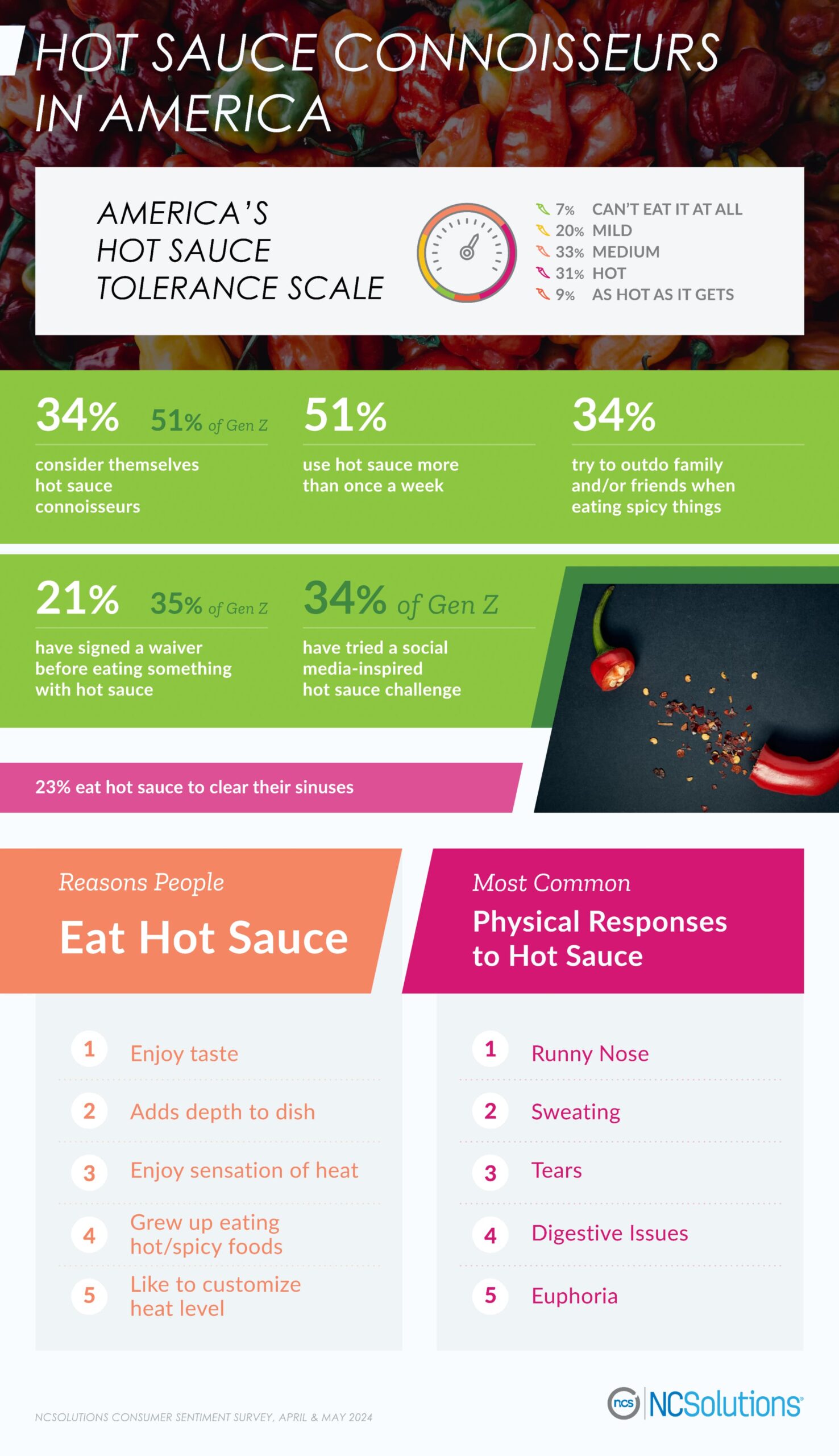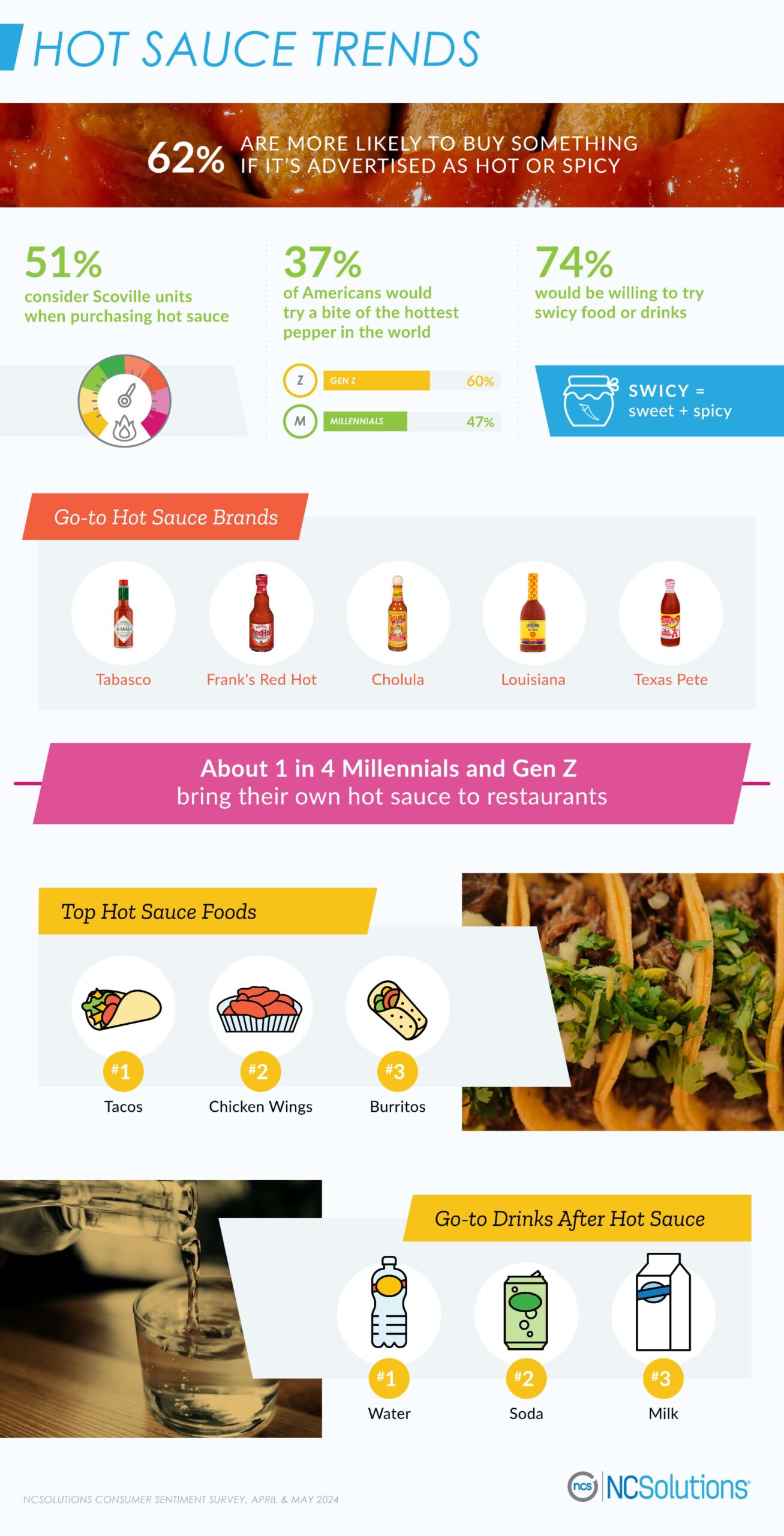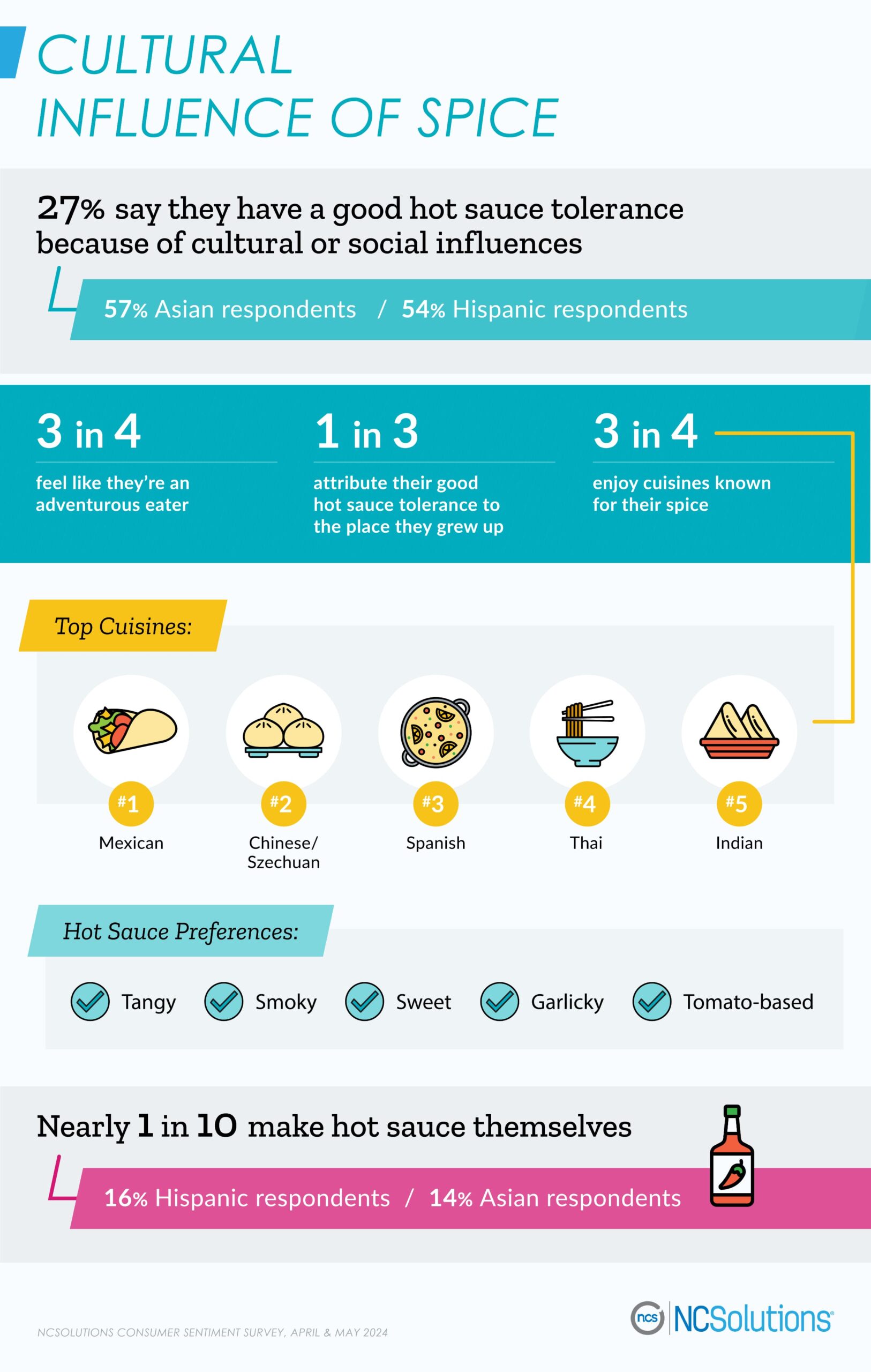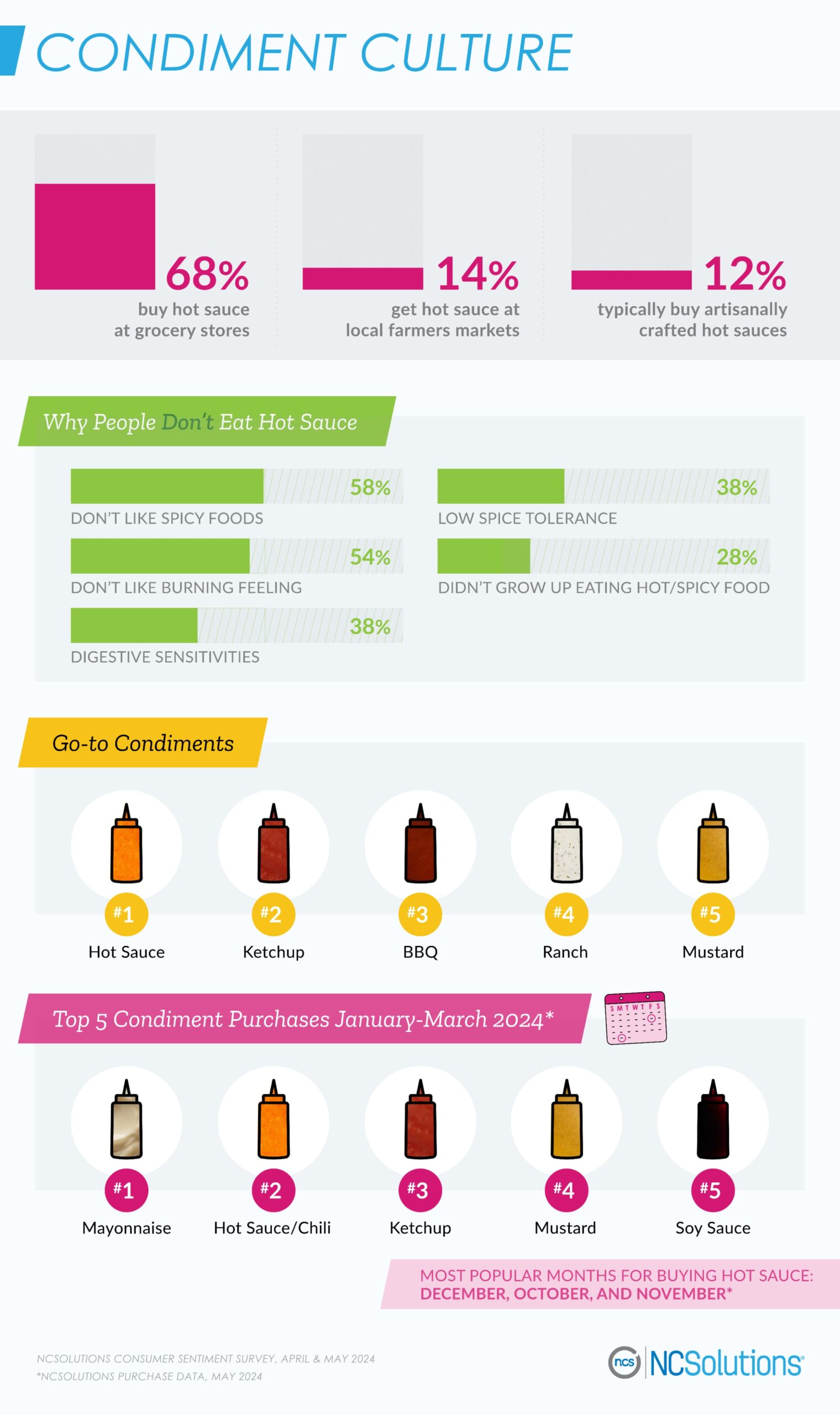Hot Sauce Market Trends: How Gen Z is Redefining Hot Sauce Culture
Hot sauce can be a polarizing topic: some can’t eat it while others can’t go without it – to the point where they even bring it to restaurants. Among hot sauce enthusiasts, this topping is more than a condiment, it’s a culture.
As Americans make homemade hot sauce, test the limits of their taste buds, and try artisanal hot sauce, one generation seems to be fueling this trend: Gen Z. In a survey of over 1,000 Americans about consumer hot sauce habits and preferences, we found Gen Z really stands out. While 34% of Americans consider themselves “hot sauce connoisseurs,” over half (51%) of Gen Zers classify themselves as one.
Five Reasons People Eat Hot Sauce

Ninety-three percent of Americans eat hot sauce, but their tolerance varies. A bold 9% say they can eat anything as hot as possible, and 31% can handle hot flavors. Meanwhile, 33% say their limit is medium, while 20% can handle mild and nothing more.
One generation is leading the charge when it comes to hot sauce: Gen Z. While 21% of Americans have been willing to sign a waiver to eat something with hot sauce, 35% of Gen Z have done the same. Their presence on social media could be a key driver. Over one in three (34%) Zoomers have tried a social media-inspired hot sauce challenge.
One respondent called hot sauce her “entire life” saying:
“I would eat hot sauce any day. It is a great conversation starter. I also really like Hot Ones and made my own Hot Ones challenge.”
Over half (51%) of Americans use hot sauce more than once a week. People are drawn to hot sauce for five common reasons:
- Enjoy the taste
- Feel it adds depth to the dish
- Enjoy the sensation of heat
- Grew up eating hot or spicy foods
- Like to customize the heat level of their meals
However, all this hot sauce comes with a physical price. Over two in three (68%) say it causes them to have a runny nose, and some end up sweating, crying, or even dealing with some digestive issues. But some Americans are hoping for that physical reaction when eating hot sauce. Nearly one in four – 23% – say they eat it just to clear their sinuses.
“Swicy” Food and Drink Trend

While sweet and spicy food isn’t a new concept, the word “swicy” is a new trendy term being used in marketing. Searches for the word on Google have increased 1,700% from March 2023 to March 2024 (the latest data available from Google at the time of this report), and three in four Americans say they would be willing to try swicy food or drinks.
Although a bold 37% of Americans would try a taste of the hottest pepper in the world, younger generations have a greater desire to test their taste buds. Sixty percent of Gen Z and 47% of Millennials said they’d try a bite.
Go-To Hot Sauces
People are passionate about the hot sauces that they use. About one in four Millennials and Gen Z bring their own hot sauce to restaurants rather than run the risk of not having it for their meal.
When it comes to buying hot sauce, 51% consider Scoville units before making a purchase. Scoville units are the measurement of how hot a pepper is rated. Over three in five (62%) are more likely to buy something if it’s advertised as hot or spicy.
People mainly buy hot sauce from the grocery store, but 14% get it at local farmers markets. While the majority of Americans stick with traditional hot sauce brands, over one in 10 (12%) like to have artisanal hot sauces. Overall, the go-to hot sauce brands people prefer are:
- TABASCO®
- Frank’s RedHot®
- Cholula®
- Louisiana Hot Sauce
- Texas Pete®
The majority of Americans prefer to douse hot sauce on tacos, chicken wings, or burritos. Around the U.S. though, certain regions put it on different foods. Those living in the South are more partial to putting hot sauce on seafood or soups and stews. In the Northeast, mac and cheese, fried rice, and hamburgers are more commonly eaten with hot sauce. Out West, people try hot sauce with their burritos and eggs.
While one in 10 Americans who are over 21 prefer to sip something alcoholic while eating something with hot sauce, the majority prefer to drink something non-alcoholic. Most drink water followed by soda or milk.
Top 5 Favorite Cuisines Known for Their Spice

Hot sauce culture drives a desire for spice that extends outside of sauce. Americans enjoy a variety of spicy foods from around the world with three in four consumers specifically enjoying cuisines known for their spice. The top cuisines Americans enjoy include Mexican, Chinese/Szechuan, Spanish, Thai and Indian.
The places where people live and grow up can strongly influence their hot sauce habits. In fact, 19% of those living in the South and 18% of those in the West say they eat hot sauce with their food because they live in a place with a lot of hot and spicy food.
While one in three attribute their high tolerance for hot sauce to their hometowns or places they currently live, 27% credit cultural or social influences for their tolerance. More than half of Asian and Hispanic survey respondents say cultural or social influences have made eating hot sauce easier.
One respondent shared his grandmother was Sicilian and that she loved eating hot sauce, so he does too. Another respondent had this to say:
“It pairs really well with soda, in my opinion, and it is a part of a lot of my culture’s traditional foods. It’s just really delicious.”
Nearly one in 10 (9%) prefer to make hot sauce themselves. Slightly more Hispanic and Asian respondents shared they make homemade hot sauce than the average American.
Reasons People Don’t Eat Hot Sauce

Hot sauce isn’t for everyone. There are five main reasons people don’t eat hot sauce:
- Don’t like spicy food
- Don’t like the burning feeling
- Digestive sensitivities
- Low spice tolerance
- Didn’t grow up eating hot/spicy food.
While most Americans still choose hot sauce as their number one condiment, the other top condiment is ketchup. Among all the generations, baby boomers were the only ones to choose ketchup as their top condiment over hot sauce. More women than men also prefer ketchup to hot sauce.
According to NCSolutions purchase data, in the first three months of 2024, mayonnaise was the top condiment purchased by consumers. Hot sauce/chili condiments were the second most popular purchase followed by ketchup, mustard, and soy sauce. Interestingly, the end of the year appears to be a more popular time for hot sauce purchases. In 2023, the biggest months for buying hot sauce were December, October, and November.
At the end of the day, everyone needs a little spice in their life. At least, that’s what one survey respondent said when we asked them why they like hot sauce. Whether you prefer to spice up your life by eating something with hot sauce or maybe just eating something new, we hope you continually find new flavorful food and drinks.
About the Consumer Sentiment Survey
The consumer sentiment survey of 1,114 Americans was commissioned by NCSolutions in April and May 2024 and was made up of U.S. adults ages 18+, who were asked about their eating habits and preferences. Results were weighted to be representative of the U.S. population by age, gender, region, ethnicity, marital status, education level, and household income.
About the NCS Purchase Data
NCS provides purchase insights to brands to help them optimize, measure, and enable sales-based outcomes.NCS’s representative and balanced consumer CPG purchase data set consists of the industry’s preeminent and comprehensive sources. It is inclusive of actual purchase data (transaction information) from big-box retailers, supermarkets, drug stores, convenience stores and other retail channels through which American households buy CPG products spanning 340+ grocery categories. The NCSolutions Purchase Data was analyzed in May 2024.
For media inquiries, please contact ncspress@ncsolutions.com.
Fair Use
When using this data and research, please attribute by linking to this study and citing NCSolutions.


